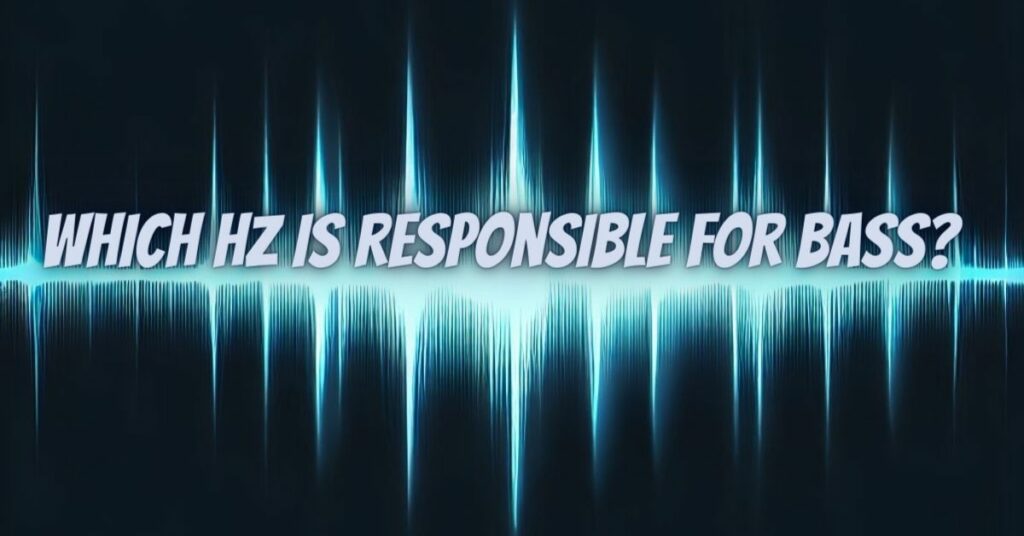Bass is a fundamental element in the world of music and audio, providing the deep, resonant tones that underpin the rhythm and harmony of a composition. When we discuss which Hz is responsible for bass, we are diving into the heart of audio frequencies. In this comprehensive article, we will explore the concept of bass frequencies, their role in music and sound, and the specific Hz ranges that give rise to the rich, powerful, and immersive low end we all love.
The Essence of Bass Frequencies
Before we delve into the specific Hz ranges, it’s important to understand the nature and significance of bass frequencies:
- The Low-End Foundation:
Bass frequencies are the lowest-pitched sounds in the audio spectrum, responsible for creating a sense of depth and resonance in music and sound. They provide the sonic foundation upon which other elements of a composition are built.
- Auditory and Physical Impact:
Bass frequencies are not only heard but also felt. They can create a physical sensation, often manifesting as a vibration or “thump” that can be felt in the body. This visceral aspect of bass adds to its emotional and immersive qualities.
- Rhythmic Anchoring:
Bass frequencies play a pivotal role in establishing and maintaining rhythm. The bassline in a song, for instance, provides a steady pulse that keeps the music moving forward and guides the listener’s sense of timing and groove.
Exploring the Bass Frequency Spectrum
The bass frequency spectrum encompasses a range of Hz values, each contributing to the overall character and impact of the low end:
- Sub-Bass (20 Hz – 60 Hz):
Sub-bass frequencies are the deepest and most profound in the bass spectrum. They typically span from 20 Hz to 60 Hz. Sub-bass is often more felt than heard and is responsible for creating a rumble or vibration. It adds a sense of power and depth to audio content and is commonly used in genres like EDM, hip-hop, and cinematic soundtracks to create intense, ground-shaking effects.
- Bass (60 Hz – 250 Hz):
The bass range encompasses frequencies ranging from 60 Hz to 250 Hz. This is where the traditional bass frequencies are found, providing warmth, body, and fullness to music. The bass guitar, kick drum, and many other instruments produce fundamental tones in this range, making it essential for defining the low end in various musical genres, including rock, funk, jazz, and more.
- Upper Bass (250 Hz – 500 Hz):
The upper bass range, spanning from 250 Hz to 500 Hz, adds definition and articulation to the low end. It ensures that the bass notes are distinct and clear, allowing them to cut through the mix and provide rhythmic precision. This range is crucial for creating a punchy and well-defined bass sound.
- Mid-Bass (500 Hz – 1,000 Hz):
The mid-bass range extends from 500 Hz to 1,000 Hz and further refines the bass sound. It adds a sense of attack and impact to the bass notes, providing a dynamic and expressive quality to the low end. This range is particularly important for instruments like the electric bass guitar.
The Role of Bass in Music
Bass frequencies are the backbone of music, and they fulfill several vital roles:
- Rhythm and Groove:
Bass frequencies establish and maintain the rhythmic foundation of a piece of music. The bassline provides the groove that drives the composition forward and keeps listeners engaged.
- Harmonic Support:
In addition to rhythm, bass frequencies provide harmonic support to the music. They reinforce the chord progressions and harmonies played by other instruments, adding depth and richness to the overall sound.
- Emotional Impact:
Bass frequencies can evoke powerful emotional responses in listeners. A deep, resonant bassline can convey a sense of depth, melancholy, or power, enhancing the emotional resonance of a composition.
- Soundstage and Immersion:
In sound design and audio production, bass frequencies are used to create a sense of space and immersion. They can simulate the rumble of thunder or the reverberation of a large, cavernous environment.
Production and Reproduction of Bass Frequencies
The production and reproduction of bass frequencies involve several factors and considerations:
- Instruments and Sound Sources:
Different instruments and sound sources generate bass frequencies. The choice of instruments, amplifiers, and recording techniques significantly influences the quality and character of the bass sound.
- Audio Equipment:
High-quality audio equipment, including subwoofers, speakers, and headphones, is essential for accurately reproducing bass frequencies. These components should be capable of handling low frequencies without distortion or loss of detail.
- Room Acoustics:
The acoustics of the listening environment can impact the perception of bass frequencies. Proper room treatment and placement of speakers or headphones can optimize the bass response.
- Equalization (EQ):
Equalization allows for fine-tuning the balance of frequencies in a mix. It is a powerful tool for adjusting the bass to achieve the desired tonal characteristics.
Bass frequencies are the bedrock of music and audio, providing depth, rhythm, and emotional impact. The specific Hz ranges responsible for bass encompass sub-bass, bass, upper bass, and mid-bass frequencies, each contributing to the overall sonic experience in unique ways. Understanding the role of these frequencies and how they interact is essential for musicians, audio engineers, and listeners alike. Whether you’re grooving to a funky bassline, feeling the intensity of sub-bass in a club, or appreciating the harmonic richness of a classical composition, bass frequencies are the heartbeat of sound, shaping our auditory world in profound and meaningful ways.


